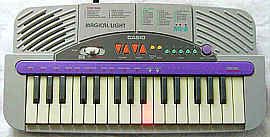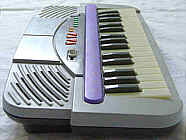 |
 |
This keyboard from 1994 (embossed case stamp date) is one of the smallest Casio keyboards with genuine key lighting (i.e. the keys itself flash red, not only an LED row above). It has 10 wonderful orchestrated demo melodies with melody guide play training (but no different levels). Unfortunately it has neither a ROM-Pack cartridge slot (see e.g. Casio PT-82) nor other means to load additional melodies, and despite midsize keys it is only 2 note polyphonic. This instrument was also released with black case, and a transparent dark blue version (light blue panel, cyan rhythm name bar) was later(?) released as Casio LK-6 (seen on eBay).
 |
 |
The "flute" is brighter and 1 octave higher than on SA-1. Also the "violin" is an octave higher (slightly less vibrato?). The famous static "brass ens" is also there and toots even more extreme than on my SA keyboards. The "synth- brass" is an octave higher too. The "church bells" have no echo here. The "rock drum" kit here has {base, snare, shaker (?), cymbal} instead of {base, snare, closed cymbal, open cymbal}; the snare is brighter, cymbal is more metallic with higher resolution and the base is less bassy. The "s.e." (="sound effects"?) consists of 4 effect sounds corresponding {"pearl drop", "car horn", "laser beam" (sound 1), "emergency alarm" (sound 2, 1 octave higher)} on the SA-1 sound set.
The rhythms sound more impulsive and have less bass than on Casio
PA-31, and they neither employ phasing effects nor there are rhythms
with accompaniment. The percussion samples sound thinner but clearer and
have likely higher resolution. E.g. the snare has more dynamics and also
the woodblock knocks very natural.
circuit bending detailsUnlike Casio SA keyboards with such a sound engine, the Casio ML-2 has instead of a 30 pin "OKI M6387-**" CPU (where ** is a 2 digit number that apparently indicates the ROM software version inside) now an "OKI M6521-11" CPU with 60 pins. The tiny Casio ML-1 has an "OKI M6521-10" CPU instead; likely the only difference is the set of built-in melodies in its song bank.The M6521-11 CPU has in the top row 8 output and 8 input pins for the keyboard matrix. In the keyboard matrix I discovered 6(?) additional cipher buttons to select more sounds, but unlike with Casio SA-2 or the SA-8 (mutilated SA-6?) here many cipher combinations play no sound at all. Apparently here not the full 100 ToneBank sound set exists, but only those additional sounds can be selected those are normally used by the built-in demo melodies. Older small Casio melody guide keyboards (see e.g. Casio PT-82) had 4 different play training levels while the ML-2 has only the "light on/ off" switch. I am not sure if the 2 missing combinations (with/ without waiting) exist as matrix eastereggs, because there are 4 connections for the melody guide mode in the matrix of those only 1 is used. Here is what I yet have analyzed: keyboard matrix
All unknown function names and in/ out numbers in this chart were chosen
by me. The input lines are active- high, i.e. react on +Vs, thus any functions
are triggered by a switch in series to a diode from one "out" to one "in"
pin.
Strange is that the hardware can light more than 2 keys simultaneously (visible during crashes) although it is only 2 note polyphonic. Perhaps there is somewhere a trick with a fixed diode somewhere in the keyboard matrix or at an unused pin to increase the polyphony (also see Casio SA-5 and SA-8), although this would make it necessary to solder a diode into each key line to work properly. The similar sized Casio SA-40 toy keyboard still had 4 note polyphony. shitshotA shitshot on the power supply line (e.g. simply by battery wiggling) often reveals very bizarre crash sounds. While some are simply loud noises like a hair dryer or pneumatic hammer, there is one astonishing piece of glitch music hidden in the CPU that sounds like Buddhist meditation music from a Tibetan or Zen monastery, consisting of a set of gongs and drums followed by a humming tone in the background. It is even quite easy to access by playing notes during shitshot. Unfortunately the resulting crash usually disables all keys and manual controls, thus a reset button should be added. (A simple opener button switch in the supply voltage line may fulfil both needs.)(I haven't analyzed this hardware further yet.) |
The instrument has a song bank of 10 lovely and complex orchestrated demo melodies those are also used for the melody guide play training feature. The demo melodies are:
| removal of these screws voids warranty... | ||
 |
||
|
|